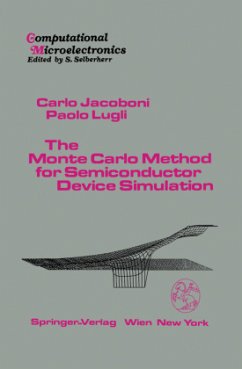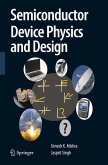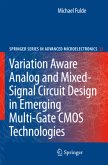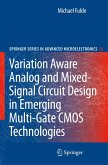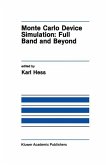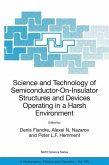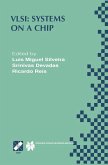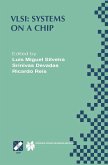- Gebundenes Buch
- Merkliste
- Auf die Merkliste
- Bewerten Bewerten
- Teilen
- Produkt teilen
- Produkterinnerung
- Produkterinnerung
The application of the Monte Carlo method to the simulation of semiconductor devices is presented. A review of the physics of transport in semiconductors is given, followed by an introduction to the physics of semiconductor devices. The Monte Carlo algorithm is discussed in great details, and specific applications to the modelling of semiconductor devices are given. A comparison with traditional simulators is also presented.
Andere Kunden interessierten sich auch für
![Semiconductor Device Physics and Design Semiconductor Device Physics and Design]() Umesh MishraSemiconductor Device Physics and Design104,99 €
Umesh MishraSemiconductor Device Physics and Design104,99 €![Variation Aware Analog and Mixed-Signal Circuit Design in Emerging Multi-Gate CMOS Technologies Variation Aware Analog and Mixed-Signal Circuit Design in Emerging Multi-Gate CMOS Technologies]() Michael FuldeVariation Aware Analog and Mixed-Signal Circuit Design in Emerging Multi-Gate CMOS Technologies75,99 €
Michael FuldeVariation Aware Analog and Mixed-Signal Circuit Design in Emerging Multi-Gate CMOS Technologies75,99 €![Variation Aware Analog and Mixed-Signal Circuit Design in Emerging Multi-Gate CMOS Technologies Variation Aware Analog and Mixed-Signal Circuit Design in Emerging Multi-Gate CMOS Technologies]() Michael FuldeVariation Aware Analog and Mixed-Signal Circuit Design in Emerging Multi-Gate CMOS Technologies75,99 €
Michael FuldeVariation Aware Analog and Mixed-Signal Circuit Design in Emerging Multi-Gate CMOS Technologies75,99 €![Monte Carlo Device Simulation Monte Carlo Device Simulation]() Karl Hess (Hrsg.)Monte Carlo Device Simulation115,99 €
Karl Hess (Hrsg.)Monte Carlo Device Simulation115,99 €![Science and Technology of Semiconductor-On-Insulator Structures and Devices Operating in a Harsh Environment Science and Technology of Semiconductor-On-Insulator Structures and Devices Operating in a Harsh Environment]() Denis Flandre / Alexei N. Nazarov / Peter L.F. Hemment (eds.)Science and Technology of Semiconductor-On-Insulator Structures and Devices Operating in a Harsh Environment77,99 €
Denis Flandre / Alexei N. Nazarov / Peter L.F. Hemment (eds.)Science and Technology of Semiconductor-On-Insulator Structures and Devices Operating in a Harsh Environment77,99 €![VLSI: Systems on a Chip VLSI: Systems on a Chip]() VLSI: Systems on a Chip150,99 €
VLSI: Systems on a Chip150,99 €![Vlsi: Systems on a Chip Vlsi: Systems on a Chip]() Luis Miguel Silveira / Srinivas Devadas / Ricardo A. Reis (Hgg.)Vlsi: Systems on a Chip226,99 €
Luis Miguel Silveira / Srinivas Devadas / Ricardo A. Reis (Hgg.)Vlsi: Systems on a Chip226,99 €-
-
-
The application of the Monte Carlo method to the simulation of semiconductor devices is presented. A review of the physics of transport in semiconductors is given, followed by an introduction to the physics of semiconductor devices. The Monte Carlo algorithm is discussed in great details, and specific applications to the modelling of semiconductor devices are given. A comparison with traditional simulators is also presented.
Produktdetails
- Produktdetails
- Computational Microelectronics
- Verlag: Springer / Springer Vienna / Springer, Wien
- Artikelnr. des Verlages: 978-3-211-82110-7
- 1989.
- Seitenzahl: 376
- Erscheinungstermin: 30. Oktober 1989
- Englisch
- Abmessung: 241mm x 160mm x 25mm
- Gewicht: 804g
- ISBN-13: 9783211821107
- ISBN-10: 3211821104
- Artikelnr.: 09225778
- Herstellerkennzeichnung Die Herstellerinformationen sind derzeit nicht verfügbar.
- Computational Microelectronics
- Verlag: Springer / Springer Vienna / Springer, Wien
- Artikelnr. des Verlages: 978-3-211-82110-7
- 1989.
- Seitenzahl: 376
- Erscheinungstermin: 30. Oktober 1989
- Englisch
- Abmessung: 241mm x 160mm x 25mm
- Gewicht: 804g
- ISBN-13: 9783211821107
- ISBN-10: 3211821104
- Artikelnr.: 09225778
- Herstellerkennzeichnung Die Herstellerinformationen sind derzeit nicht verfügbar.
1 Introduction.- References.- 2 Charge Transport in Semiconductors.- 2.1 Electron Dynamics.- 2.2 Energy Bands.- 2.3 Scattering Mechanisms.- 2.4 Scattering Probabilities.- 2.5 Transport Equation.- 2.6 Linear Response and the Relaxation Time Approximation.- 2.7 Diffusion, Noise, and Velocity Autocorrelation Function.- 2.8 Hot Electrons.- 2.9 Transient Transport.- 2.10 The Two-dimensional Electron Gas.- References.- 3 The Monte Carlo Simulation.- 3.1 Fundamentals.- 3.2 Definition of the Physical System.- 3.3 Initial Conditions.- 3.4 The Free Flight, Self Scattering.- 3.5 The Scattering Process.- 3.6 The Choice of the State After Scattering.- 3.7 Collection of Results for Steady-State Phenomena.- 3.8 The Ensemble Monte Carlo (EMC).- 3.9 Many Particle Effects.- 3.10 Monte Carlo Simulation of the 2DEG.- 3.11 Special Topics.- 3.12 Variance-reducing Techniques.- 3.13 Comparison with Other Techniques.- References.- 4 Review of Semiconductor Devices.- 4.1 Introduction.- 4.2 Historical Evolution of Semiconductor Devices.- 4.3 Physical Basis of Semiconductor Devices.- 4.4 Comparison of Semiconductor Devices.- References.- 5 Monte Carlo Simulation of Semiconductor Devices.- 5.1 Introduction.- 5.2 Geometry of the System.- 5.3 Particle-Mesh Force Calculation.- 5.4 Poisson Solver and Field Distribution.- 5.5 The Monte Carlo Simulation of Semiconductor Devices.- References.- 6 Applications.- 6.1 Introduction.- 6.2 Diodes.- 6.3 MESFET.- 6.4 HEMT and Heterojunction Real Space Transfer Devices.- 6.5 Bipolar Transistor.- 6.6 HBT.- 6.7 MOSFET and MISFET.- 6.8 Hot Electron Transistors.- 6.9 Permeable Base Transistor.- 6.10 Comparison with Traditional Simulators.- References.- Appendix A. Numerical Evaluation of Some Integrals of Interest.- References.- Appendix B. Generation of Random Numbers.- References.
1 Introduction.- References.- 2 Charge Transport in Semiconductors.- 2.1 Electron Dynamics.- 2.2 Energy Bands.- 2.3 Scattering Mechanisms.- 2.4 Scattering Probabilities.- 2.5 Transport Equation.- 2.6 Linear Response and the Relaxation Time Approximation.- 2.7 Diffusion, Noise, and Velocity Autocorrelation Function.- 2.8 Hot Electrons.- 2.9 Transient Transport.- 2.10 The Two-dimensional Electron Gas.- References.- 3 The Monte Carlo Simulation.- 3.1 Fundamentals.- 3.2 Definition of the Physical System.- 3.3 Initial Conditions.- 3.4 The Free Flight, Self Scattering.- 3.5 The Scattering Process.- 3.6 The Choice of the State After Scattering.- 3.7 Collection of Results for Steady-State Phenomena.- 3.8 The Ensemble Monte Carlo (EMC).- 3.9 Many Particle Effects.- 3.10 Monte Carlo Simulation of the 2DEG.- 3.11 Special Topics.- 3.12 Variance-reducing Techniques.- 3.13 Comparison with Other Techniques.- References.- 4 Review of Semiconductor Devices.- 4.1 Introduction.- 4.2 Historical Evolution of Semiconductor Devices.- 4.3 Physical Basis of Semiconductor Devices.- 4.4 Comparison of Semiconductor Devices.- References.- 5 Monte Carlo Simulation of Semiconductor Devices.- 5.1 Introduction.- 5.2 Geometry of the System.- 5.3 Particle-Mesh Force Calculation.- 5.4 Poisson Solver and Field Distribution.- 5.5 The Monte Carlo Simulation of Semiconductor Devices.- References.- 6 Applications.- 6.1 Introduction.- 6.2 Diodes.- 6.3 MESFET.- 6.4 HEMT and Heterojunction Real Space Transfer Devices.- 6.5 Bipolar Transistor.- 6.6 HBT.- 6.7 MOSFET and MISFET.- 6.8 Hot Electron Transistors.- 6.9 Permeable Base Transistor.- 6.10 Comparison with Traditional Simulators.- References.- Appendix A. Numerical Evaluation of Some Integrals of Interest.- References.- Appendix B. Generation of Random Numbers.- References.

